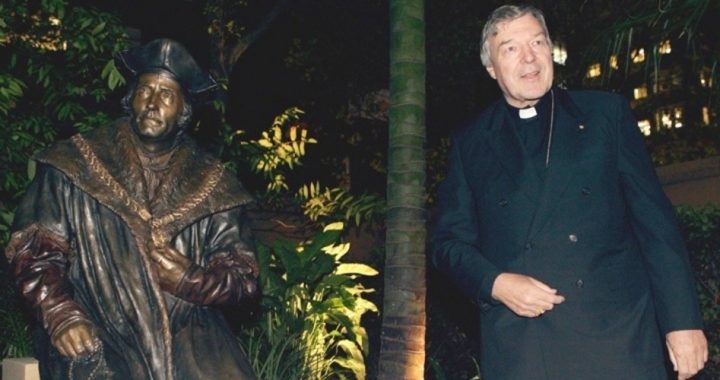
King David, in the Old Testament, spoke with the wisdom of profound and dramatic experience: “Put not your trust in princes, nor in the sons of men, in whom there is no help” (Psalm 146, verse 3, King James Bible). It is a phrase which Australia’s adherents of the Catholic Church must now ponder with renewed application. To understand the import of this — and to ascertain the possible implications of this Australian development for American believers — we must first grasp the general demographics of antipodean religious practice.
Catholicism is the largest single religious body in Australia now. (All the figures in this paragraph, and in the next paragraph, are taken from the 2011 national census.) The 5.4 million Australians who identify themselves as Catholics constitute slightly over one-fourth — 25.3 per cent — of the country’s total population. In second place — though until the 1980s it was securely in first place — is the Anglican Church, with which 17.1 per cent of Australians identified in 2011. The Uniting Church (a 1977 amalgamation of Presbyterian, Methodist and Congregationalist parishes) comes third nationally, with 5 per cent. All other Christian communities, including traditional Presbyterianism, are smaller still. Persons who state that they belong to non-Christian religions amount to 7.2 percent.
Nevertheless, the most consistent growth area among Australians — accounting for 31.7 per cent of the populace — has been that of “no religion.” There is every reason to suppose that already the 31.7 per cent figure of 2011 is out of date, and that the next census (due in 2016) will show a higher number still in that box. No Australian Bureau of Statistics data exist to determine the earlier allegiances, if any, of the non-religious. We therefore do not know — either from the Australian Bureau of Statistics itself, or from any private source analogous to America’s Pew Research Center — how many individuals in the 2011 “no religion” category are ex-Catholics, how many ex-Anglicans, how many ex-Lutherans, and so forth.
But to quote Henry David Thoreau: “some circumstantial evidence is very strong, as when you find a trout in the milk.” Much which is relevant to Australia can be gleaned suggestively, if not always conclusively, from American sources. The Pew Research Center’s report of June 13, 2008 revealed that the proportion of ex-Catholics in the U.S.A. had grown to fully 10 per cent of the total population. American Catholicism has undergone a spectacular hemorrhaging in terms of membership. The only reason this has not been automatically obvious in national Catholic statistics (since self-identified Catholics still account for around 25 per cent of Americans, just as they do for around 25 per cent of Australians) is that Hispanic immigration, much of it notoriously illegal, has thus far stanched the outward flow of members from that church. The National Catholic Reporter announced on February 11, 2011:
There are now 22 million ex-Catholics in America, by far the greatest net loss for any religious body. One in three Americans raised Catholic have left the church. Were it not for immigration, Catholicism in America would be contracting dramatically: for every one member the church adds, it loses four.
So much for Catholicism in America. What of Catholicism in Australia? Why is it imperiled these days as never before in its 225-year history?
To this last question, the fundamental answer can be very simply conveyed: In the 1970s Australian Catholicism made a misguided and dangerous, however well-intended, bargain with the Total State. The current screaming-headlines coverage of Catholic sex scandals — above all, of sex scandals in Victoria and New South Wales — ensures that in 2013 this bargain is not merely immoral, but untenable. Few events in modern Western history furnish more obvious proof of the ancient proverb: “He who sups with the Devil should use a long spoon.”
Was the misbegotten church-state “partnership” the sole cause of Australian Catholicism’s current dreadful problems? By no means. Nobody has ever suggested that it was. Given the upheavals that befell Catholicism throughout (and, to a lesser extent, beyond) the West after the Second Vatican Council of 1962-1965 — Pope Paul VI referred, in 1972, to the process as “auto-demolition” — an existential crisis might well have afflicted Australian Catholics in any case. Yet the de facto amalgamation of church and state not only failed to alleviate the crisis’s specific symptoms in Australia. In addition, it ensured that the crisis would be particularly severe locally, because Big Government had been accorded leverage over antipodean churches — by no means always Catholic — which, in the churches of happier lands, it simply did not acquire.
The Historical Backdrop
During the earliest days of Australia’s European settlement (which began in 1788), Catholicism was banned in theory but tolerated in practice. In 1831 — as outlined in the Spring 2010 edition of Britain’s Salisbury Review — all remaining statutory limitations on Catholic observance in Australia were abolished, as were Anglicanism’s formal privileges, by (Anglican) Governor Richard Bourke. Of course, as we know from American history, attitudes cannot be legislated into oblivion. On balance, until the 1970s, being a Catholic in Australia was more of a disadvantage than a help (and predictably, being an ex-Catholic was — as it remains — a guarantee of lifelong affluence). True, Australia had no Ku Klux Klan; and it elected its first Catholic Prime Minister (James Scullin) in 1929, only a year after New York Governor Al Smith had soundly lost his presidential campaign on the Catholic issue. Yet as late as 1958 Scottish-born newspaper editor John Douglas Pringle — no friend of the Vatican, and unaffiliated with any Christian group — felt impelled to write thus:
Anti-Catholic feeling is extremely strong in Australia. From time to time it bursts out like lava from a sleeping volcano, burning and destroying everything it touches … once allowed to escape it is inclined to sweep with it a very large proportion of the population who have no religious views at all.
The greatest grievance of Australian Catholics was being compelled to subsidize public schools that they themselves never used. In the 1960s the demand that Catholics’ own schools be afforded State Aid — the preferred phrase of both adherents and opponents — became louder than ever. Sir Robert Menzies, prime minister since 1949 (and Presbyterian all his life), owed most of his 1963 election victory to promising Catholic voters that state aid for their parochial education system would be forthcoming. Yet the opposition Labor Party, despite or because of its large Catholic contingent, had deplored state aid for ages. Only after 1967 did a new, modish, and agnostic federal Labor leader, Gough Whitlam, permit approval of state aid to be included in Labor’s platform. Even then he incurred vituperative opposition within his own ranks. The Victorian parliament’s militantly anti-state aid Labor movement preferred severe defeat at the 1970 state election to partaking of pro-state-aid policy in place at federal level. Finally, following Whitlam’s accession to the Prime Ministry in 1972, the deed was done. Bipartisan support for state aid became institutionalized. And every Catholic school in Australia received unprecedented governmental munificence that has continued ever since. The surreal pro-state-aid unity-ticket of Catholic conservatives like Melbourne layman B.A. Santamaria, Catholic liberals like Melbourne poet Vincent Buckley, and secularists like Whitlam had triumphed. As in the 1960s with U.S. President Lyndon Johnson’s Great Society, so in the 1970s with Australia’s churches: It became an article of unquestionable faith that every problem could be solved by throwing other people’s money at it. (Much of the detail in this process can be found — told by a hostile left-winger named Max Wallace — in the Spring 2012 number of the periodical Dissent.)
Readers will by now have guessed the tragic practical consequences of state aid in terms of Catholicism (consequences for which, when they became inescapable, Santamaria angrily reproached himself). Catholic doctrine, easy enough to enforce in classrooms back when parents disgusted at heterodox teaching could vote with their pocketbooks, became impossible to uphold when the nihilist pedagogue was being as lavishly cosseted by taxpayers as was the faithful believer. Given that instruction in Catholic seminaries also hugely benefited from injections of government funding — and given that after 1968 the number of seminary candidates within Australia had plunged — houses of priestly formation became little more than dumping-grounds for publicly funded homosexual cliques. Just how pernicious these cliques were, during the 1970s and 1980s above all; how much they owed to the influence of fellow homosexual activists like the sinister church-employed psychologist Ronald Conway; how successful their infiltration of Australian Catholic management actually was; and how, in the prevailing atmosphere of unsupervised Dionysiac license, ordained heterosexuals found it easy to rape underage girls: these four stubborn facts have emerged — as has much else — with horrifying ancillary detail. They have emerged for two reasons and for two reasons alone: the ease with which the Internet allows shocked Catholic laity in Australia (unconstrained by the local print media’s absurdly punitive defamation laws) to demand official action on the church’s scandals; and still more, the Victorian parliament’s current inquiry into religious sex abuse. A royal commission at the national level, instigated by Julia Gillard — then prime minister — in November 2012, will follow up the Victorian inquiry’s work.
Notwithstanding the dire examples of Catholicism in Boston, Milwaukee, and Los Angeles before its eyes, Australia’s Catholic episcopate ignored the clamor for leadership as long as it could. In the teeth of available evidence, it alleged — when it condescended to notice the topic at all — that the clamor was little more than gossiping by anti-Catholic troublemakers. No Catholic bishop sings that foolish song any more. George Cardinal Pell (shown at top of article), Archbishop of Sydney since 2001 after having served for the preceding five years in Melbourne, reluctantly agreed to appear and to be cross-examined at the inquiry’s sessions. So did Cardinal Pell’s successor in the Melbourne see, Archbishop Denis Hart, celebrated less for any theological significance than for telling a female abuse victim: “Go to hell, b***h” (The Age [Melbourne], August 11, 2009).
The results of such cross-examining have inspired an appalled fascination among television viewers throughout the land. At one especially harrowing point, Cardinal Pell sought to explain earlier ecclesiastical appeasement of erotically voracious priests by saying that in the 1970s “there were no protocols and no procedures” (Sydney Morning Herald, May 27) to be invoked against such priests. Apparently in the Cardinal’s own parallel universe, we all need explicit protocols before we can conclude that sacerdotal rapists preying on children warrant reproach.
Both Cardinal Pell and Archbishop Hart, amidst their unwilling and maladroit apologies to individual victims’ families, attempted to place all the blame for the situation upon the Cardinal’s Melbourne predecessor: the late Sir Francis Little, archbishop from 1974 to 1996. Why they themselves should be believed on this score, considering their own history of having ranked with Little’s closest lieutenants, is not immediately clear. In any event, the Cardinal — after, rather than before, his grueling inquiry appearance — conveyed the impression that, going one better than France’s Bourbons, he has learned nothing and forgotten everything. When Julia Gillard promised (as reported in a front-page story by The Australian on May 30) that her government would actually increase its subsidies to Catholic schools — she mentioned the planned total figure of $14.5 billion — the Cardinal persisted in his delusion that Australian Catholicism had secured federal grants by some kind of divine right. Loud was his pique (shared by the National Catholic Education Commission) at even the vaguest hint that such subsidies might be reduced. In plain language, the Cardinal — for all his pugnacious talk about independence — sees nothing wrong with being a heathen regime’s pensioner, as long as his preferred religious superstructure benefits from such a regime’s largess.
Alas for the sanguine hopes that the Cardinal retains, the truth of such largess was spelled out by William F. Jasper in The New American itself on July 21, 1997, using five words: “What government subsidizes, it controls!” Author Felix Gills had earlier noted of the U.S. scene (Philadelphia Inquirer, March 30, 1995):
In the 1960s, when federal aid to students in higher education was launched, Congress assured colleges there would be no strings attached. Then came affirmative action legislation.
How much conceivable worth can high-sounding governmental blather about preserving “religious freedom” (or “academic freedom”, or whatever other freedom you please to cite) possess anywhere? Five decades of public pedagogy throughout the English-speaking world have demonstrated, again and again, such blather’s sheer — and in most cases deliberate — fraudulence.
What Must Be Done
The following procedures are the only possible methods by which the continuing crisis in Australian Catholicism (at present, no more than 15 per cent of Australian Catholics even turn up at church on Sundays) might be susceptible to easing. The crisis is only secondarily sexual. Primarily it is a crisis of authority, and in more limited terms, of the disastrous outcomes inseparable from half a century of reposing blind trust in Big Brother.
First, the separation of school and state. Without the constant extortion of funding from the taxpayer (who could himself be, and often is, vehemently opposed to everything the churches represent), the schools of Australia’s mainline churches would nearly all close down. Australian Catholicism’s system of parochial schooling — or rather, the system of Australian parochial schooling which stridently purports to be Catholic — cannot survive the current outrage, unless the responsibility for the system’s maintenance is put squarely on the church itself. The same with Anglican schools, Uniting Church schools, Lutheran schools, and what not. Islam, Hassidic Judaism, and the Society of Friends have all conclusively demonstrated (in their various ways) that genuinely private religious schooling is entirely workable in even a society as socialistic as Australia’s, if — and solely if — the will to freedom from tyranny exists.
Second, a clear official commitment by Australian Catholicism (and other branches of Australian Christianity) to encourage homeschooling. By American standards, Australian homeschooling remains limited, hedged about with pettifogging legal restrictions, and unpopular. It is increasingly becoming less so. Even the Australian Broadcasting Corporation — in a report of January 29, 2012 which complained that “the authorities appear reluctant to prosecute [homeschoolers]” — had to admit in the same report that the number of homeschooled Australian students was “more than 50,000.”
Third, the resignations of Cardinal Pell and Archbishop Hart. These can no more be long postponed. Every day on which both men cling to their offices is a day of exacerbated shame for their co-religionists. Whatever the precise levels of either man’s technical guilt or innocence, both men’s reputations have been permanently ruined by their defensive bungling before the Victorian parliamentary committee. Television coverage of the committee’s hearings has seen to that. For better or worse, these bishops can no more recover from the embarrassing spectacle of their prime-time news-bulletin ineptitude, than Johnson in 1968 could recover from Walter Cronkite’s prime-time censure of presidential policy concerning Vietnam. In future Australian culture wars against centralizing pagan despotism, either man’s presence on the Judeo-Christian side will be not merely useless but harmful. An authority figure can do great things when he is hated. He can do nothing of merit when he is despised.
The future royal commission will, as the prelates themselves appreciate, be an even tougher test. Let them recall Shakespeare’s words in Othello:
Good name in man or woman, dear my lord,
Is the immediate jewel of their souls.
Who steals my purse, steals trash. ‘Tis something, nothing;
‘Tis mine, ‘tis his, and has been slave to thousands.
But he who filches from me my good name
Robs me of that which not enriches him
And makes me poor indeed.
By the way, the widespread notion that Catholics are in honor bound to abide by any ruling from their clergy is a myth: an enduring myth, but a myth. St. Thomas Aquinas, generally considered the greatest of all Catholic theologians, wrote: “When the faith is endangered, a subject ought to rebuke his prelate even publicly.” A hundred years later, in the 14th century, St. Catherine of Siena proclaimed: “We have had enough of exhortations to be silent. Cry out with a hundred thousand tongues! I see the world is rotten because of silence.”
None of these three recommendations touches upon specific Catholic policy with regard to removing sex criminals from Catholic institutions. Discussing that subject here would be needless and, to most non-Catholic readers, boring. After all, a substantial literature — mostly but not wholly American — from experts like Michael Rose (responsible for the profoundly influential volume Goodbye, Good Men) has emerged regarding how Catholic bishops can “man up” enough to compel such in-house reforms. Supposing that all three of the above recommendations were carried out, then Australian Catholicism’s societal collapse — the sort of collapse which the world has seen with modern Ireland, where diplomatic relations with the papacy have been cut, and where merely to wear clerical garb is to be spat on in Dublin’s streets — would still be possible.
But unless all three are carried out, such a societal collapse is absolutely assured. In this environment, remembrance of a daunting epigram by German historian Oswald Spengler cannot be legitimately avoided. “Optimism,” warned Spengler, “is cowardice.”
Photo at top shows George Cardinal Pell next to statue of St. Thomas More, who was beheaded for putting his allegiance to God above his allegiance to the State as represented by King Henry VIII; photo source: AP Images
R.J. Stove is a Catholic who lives in Melbourne.



